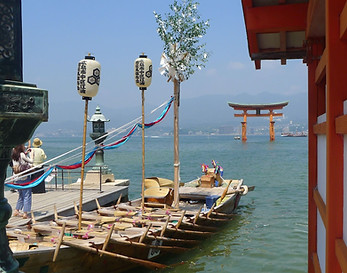
Hiroshima

Two world heritages, Itsukushima Shrine and Atomic Bomb Dome
Hiroshima prefecture is located close to the west end of Japan’s main island, Honshu. Its southern coast faces the Seto Island Sea and the north west is blocked by the Chugoku mountains.
Hiroshima is widely known as two world heritages; Itsukushima Shrine known as its floating torii gate off Miyajima Island and Atomic Bomb Dome.



Along Ōta-gawa river stands the Atomic Bomb Dome (Genbaku Dome), one of the few remaining building after a bomb dropped on August 6, It is located in Peace Memorial Park along with several monuments to pray for eternal peace.
Miyajima Island is a home of one of the most famous torii gate of Japan, standing in the middle of waves when a tide is high.

The torii gate belongs to Itsukushima Shrine that has more than 1400 years of history, and entertains tourists with different sceneries depending on the height of tides.

Hiroshima-yaki - Hiroshima style of Okonomiyaki, which is noodle filled savory pancake with cabbage, green onion, bean sprout, and sliced pork belly
No.1 production of Lemon and farm-raised oyster in Japan.

Brushes made in Kumano and Kawajiri are popular local products in Hiroshima. The production started in late 19th century as other source of income outside of agriculture for people in these areas.
Koto, Japanese harps, made in Fukuyama are popular not only for its beautiful tones but also for their elegant decoration. Miyajima Zaiku are wooden art crafts made in Miyajima that uses local woods in that area.

MOMENTO
Yosui Tsuji
Born from inspiration exclusively for New Yorkers
Combination of a couple of different pieces; a coffee sign, light stands, and picture frames (the above picture represents only light sands) were made exclusively for New Yorkers. Similar to jazz, it was made from Yosui's improvisation.
HEXa
Grind Architects
Kateda+Maeda
HEXa is an upgrade on the traditional wooden square sake cup “masu,” which has 1,300 years of history in Japan. The product actively seeks out three Hiroshima-produced lumber that have steadily declined in recent years: hinoki cypress, stiff-leaved juniper and Japanese bigleaf magnolia. All three species are valuable for their beautiful wood grain, refreshing aroma and high durability and water resistance. The round outer edge evokes the notion of “forever,” and the parts are joined by a method called “irikumi,” which is also wordplay with “oiri” (full house). Fittingly, the product has been popular for Japanese cultural events such as Japanese-style weddings and cherry blossom viewing. By not limiting the material to hinoki cypress, the product actually has a wider range of use as wooden tableware. While the conventional square masu can be hard to drink from, HEXa’s combination of hexagon and circles, shapes frequently found in nature, results in a beautiful and modern design that is also easy to grip and fits along the mouth, even for women and children. Due to the hexagonal shape, it requires the expertise of artisans with skilled woodworking techniques to join the parts without any space. Through numerous trial and error with artisans, each process from cutting to joining and polishing is done by hand to create this remarkable product of craftsmanship and philosophy.

